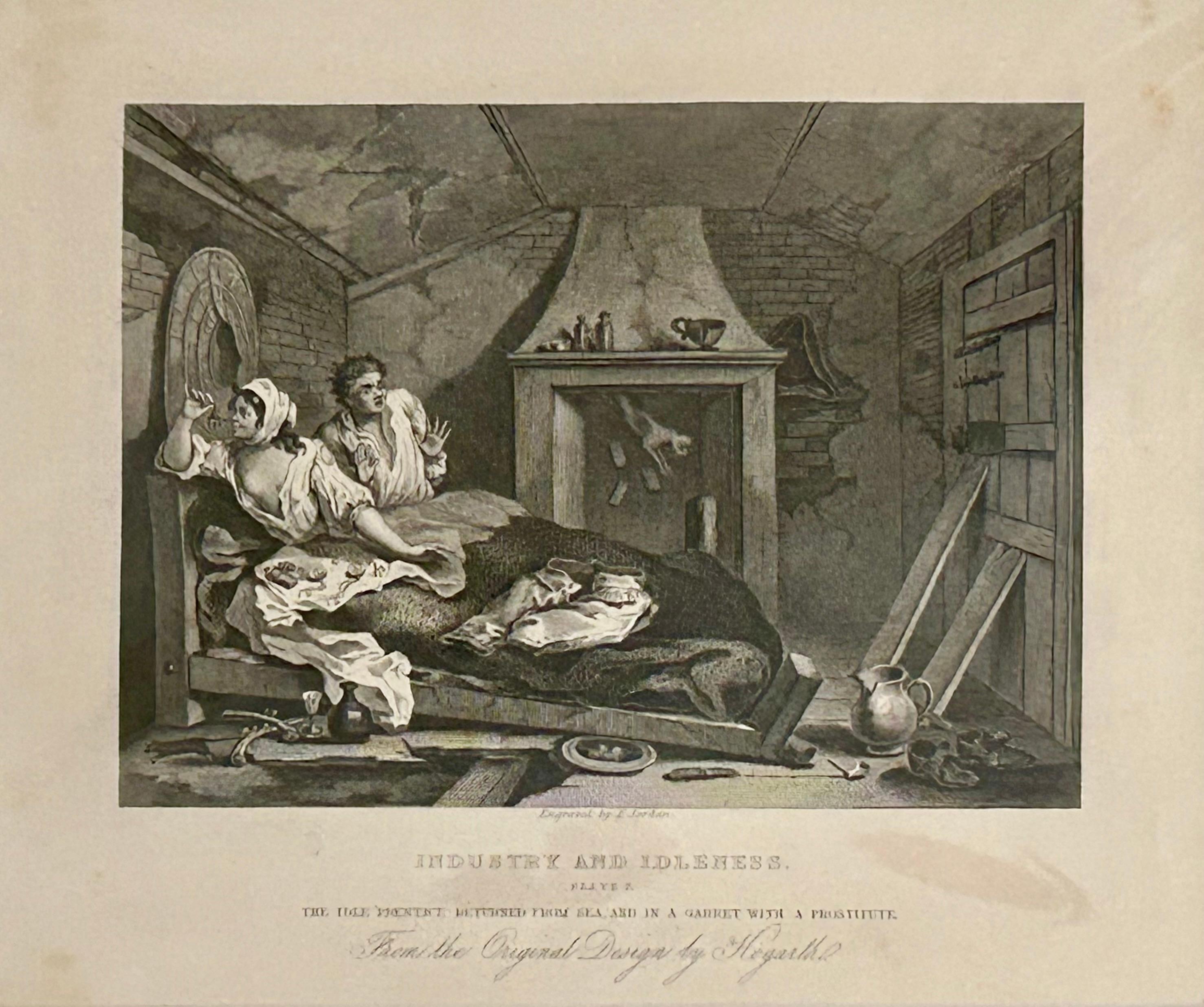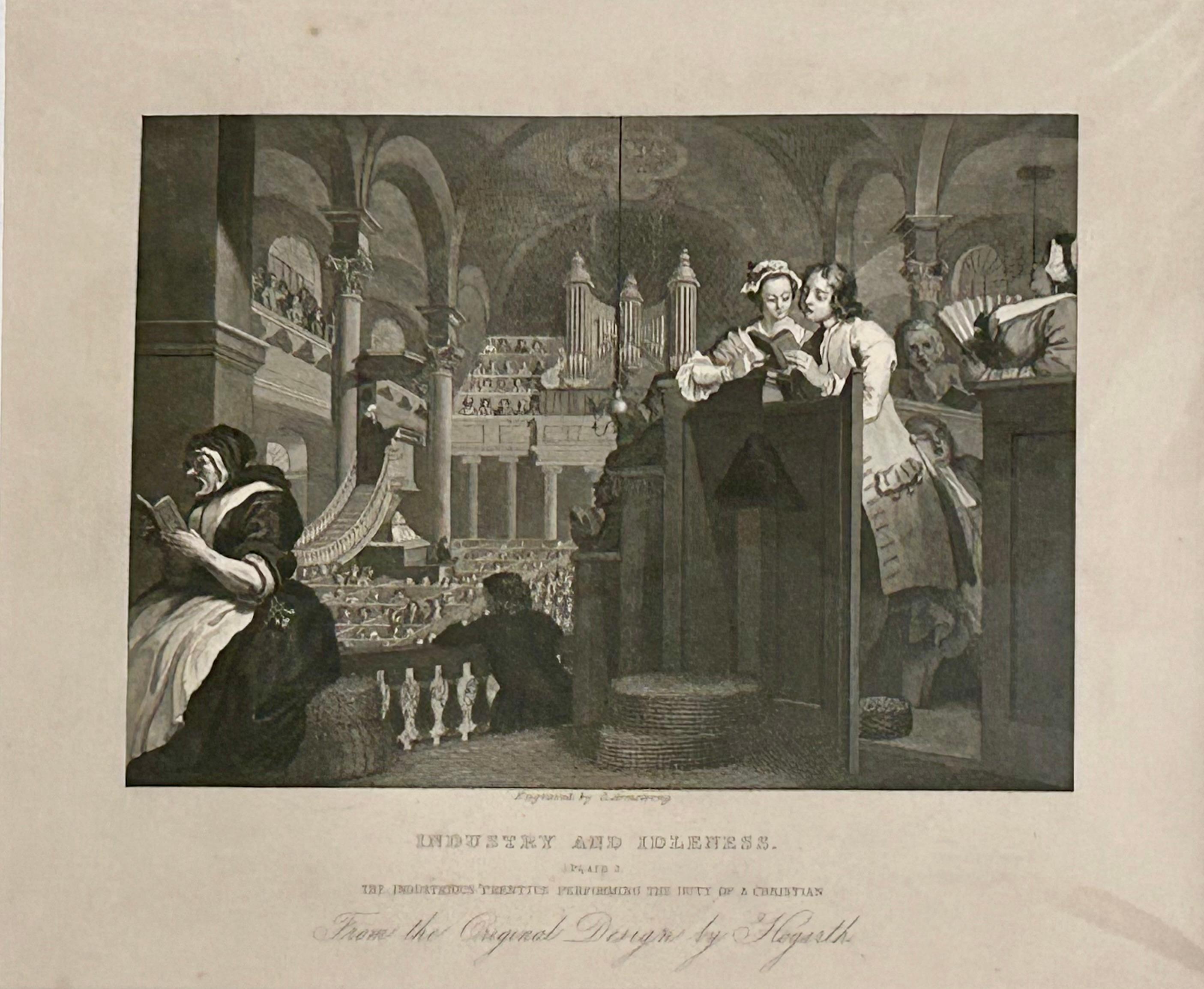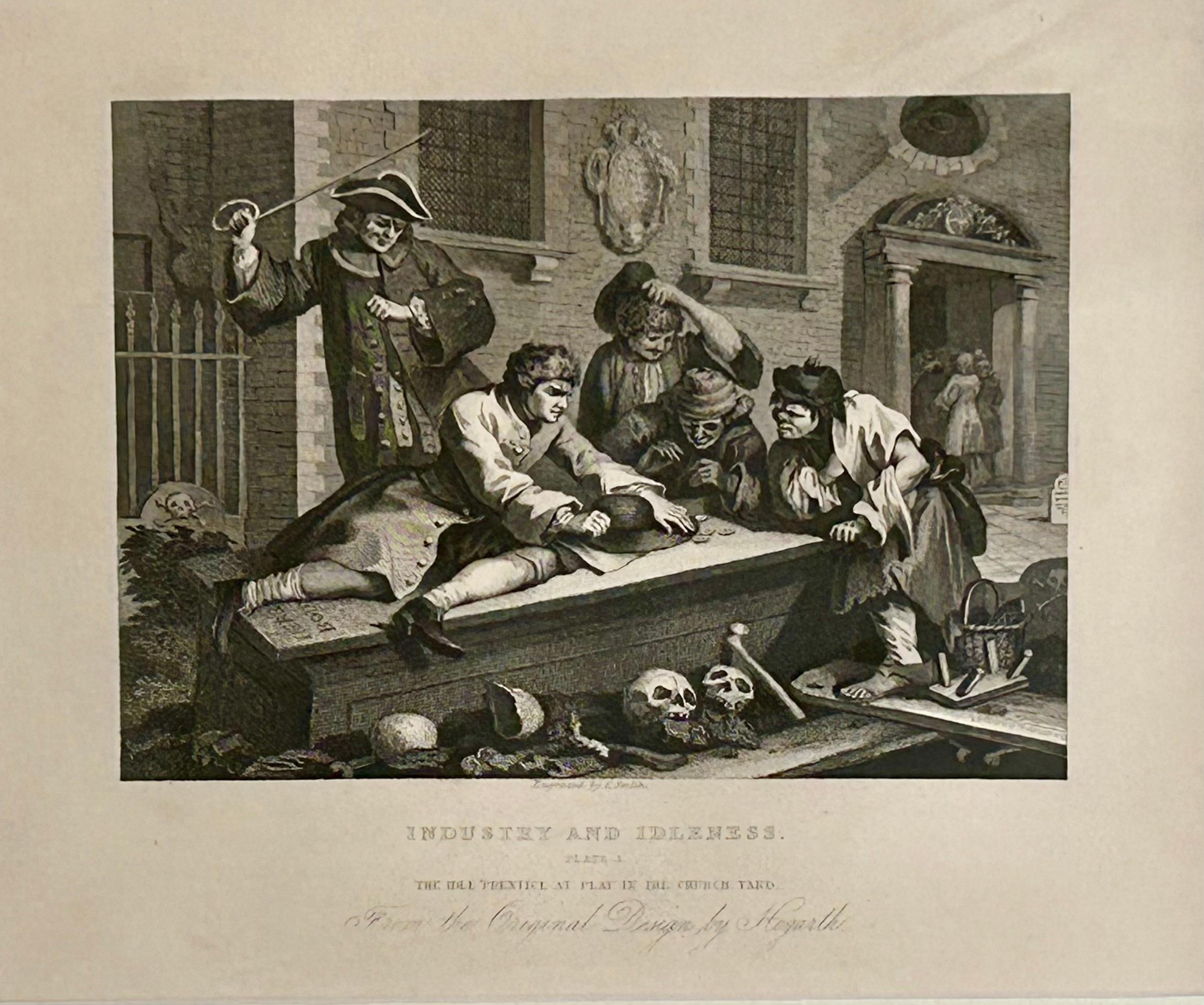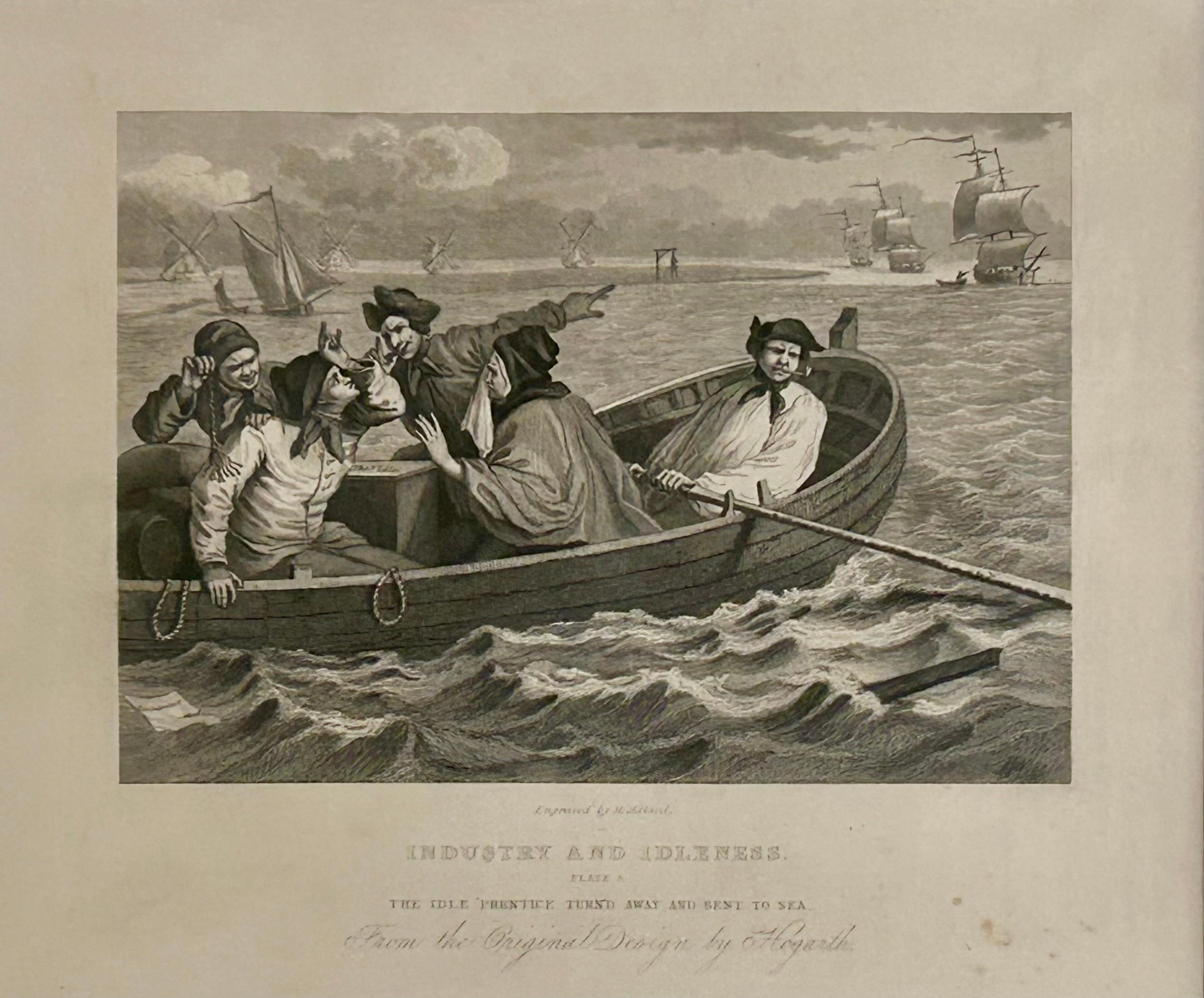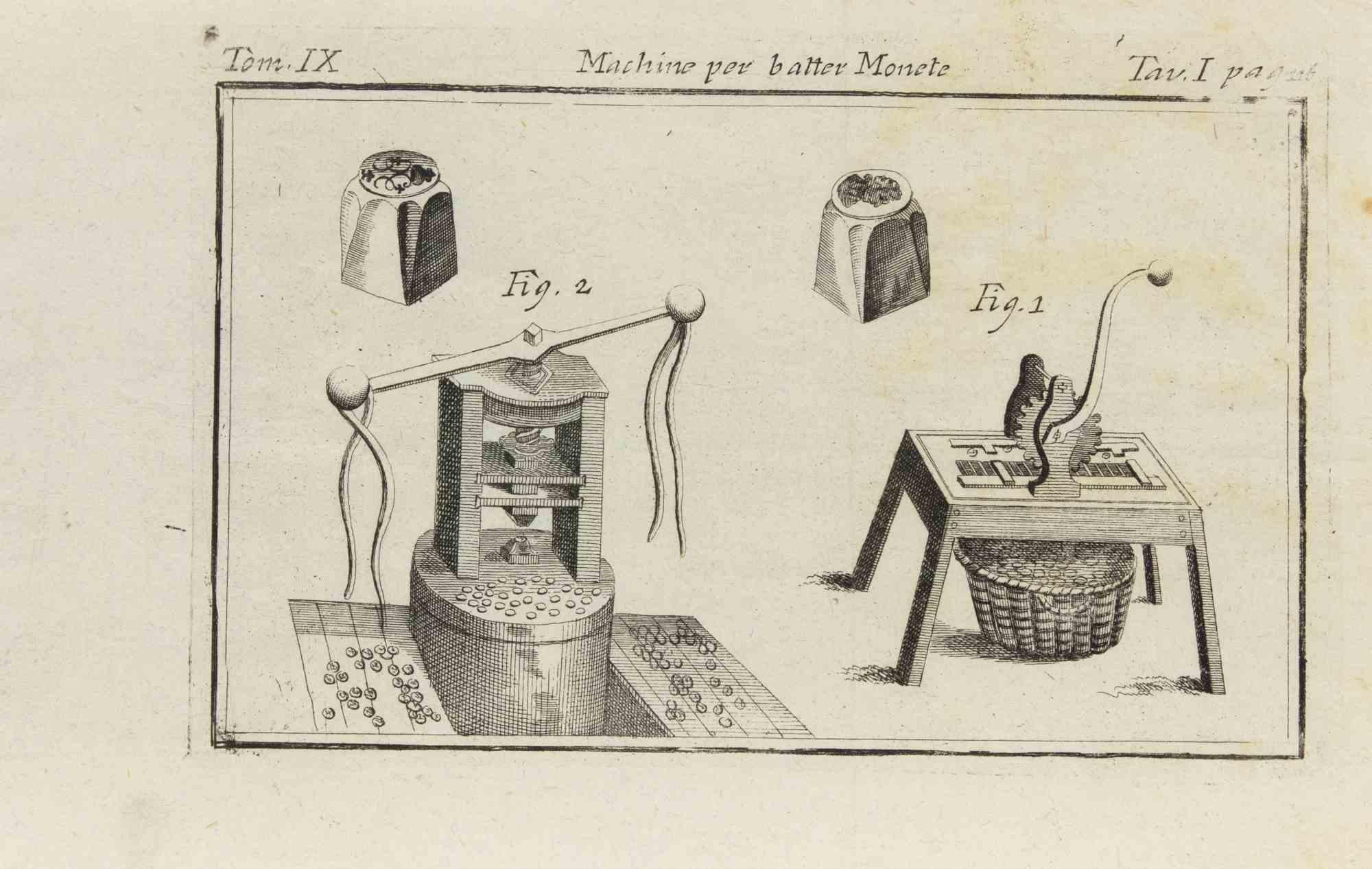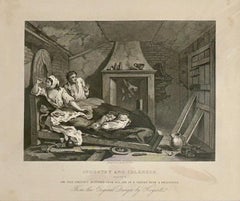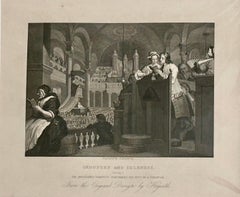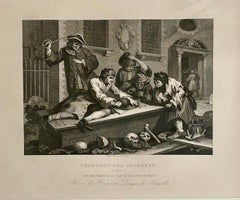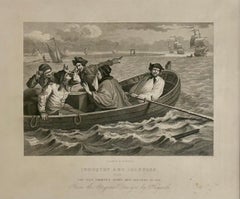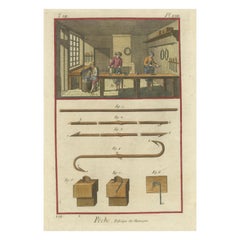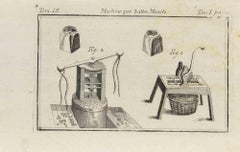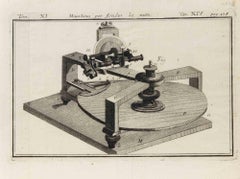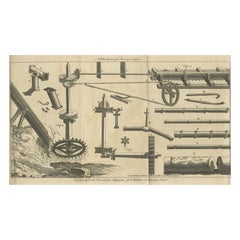Items Similar to Industry and Idleness Plate 1: The Fellow 'Prentices at their Looms
Want more images or videos?
Request additional images or videos from the seller
1 of 4
Industry and Idleness Plate 1: The Fellow 'Prentices at their Looms1830
1830
$185.62
$232.0220% Off
£136
£17020% Off
€158.48
€198.1020% Off
CA$256.07
CA$320.0820% Off
A$280.47
A$350.5920% Off
CHF 147.67
CHF 184.5920% Off
MX$3,347.34
MX$4,184.1820% Off
NOK 1,881.90
NOK 2,352.3820% Off
SEK 1,720.34
SEK 2,150.4320% Off
DKK 1,184.25
DKK 1,480.3120% Off
About the Item
William Hogarth was an English painter and engraver, the outstanding British artist of his period. During his childhood, his father, a schoolteacher, was imprisoned for debt, and this early experience of the seamy side of life left a deep mark on Hogarth (much of his output is concerned with the contrast between success and failure, and he depicted prisons in several works). He trained as an engraver of silver plate and by 1720 had set up his own business in London, doing various kinds of commercial work. In his spare time he studied painting, first at the St Martin's Lane Academy and later under Sir James Thornhill, whose daughter he married in 1729. By the early 1730s he had achieved some success as a painter of conversation pieces and at about the same time he invented the idea of using a sequence of anecdotal pictures ‘similar to representations on the stage’ to point a moral and satirize social abuses.
A set of 12 original engravings illustrating Industry and Idleness, after the drawings by William Hogarth, printed in 1833. The engravers are F Jordan, E Smith, C Armstrong, S Davenport, H Adlard, W H Worthington, H Fernell, A Duncan and F F Walker. The engravings, which are in excellent condition, would be mounted (matted) and ready to frame
Edward Smith (fl. 1823-49)
The landscape, figure, and portrait engraver Edward Smith may have been a native of Edinburgh but appears to have worked mostly in London. His earliest recorded plates are for Effigies Poeticae in 1823. He went on to contribute to Hogarth Moralized (1831), Hogarth's Works (1833)
Read moreText source: The Oxford Dictionary of Art and Artists (Oxford University Press)
Engraved from the original by Wm Hogarth
Minor Foxing
About the Seller
5.0
Gold Seller
Premium sellers maintaining a 4.3+ rating and 24-hour response times
Established in 2021
1stDibs seller since 2021
39 sales on 1stDibs
Typical response time: 3 hours
- ShippingRetrieving quote...Shipping from: Bournemouth, United Kingdom
- Return Policy
More From This Seller
View AllIndustry and Idleness Plate 7: The Idle 'Prentice Returned From Sea
By William Hogarth
Located in Bournemouth, Dorset
William Hogarth was an English painter and engraver, the outstanding British artist of his period. During his childhood, his father, a schoolteacher, was imprisoned for debt, and th...
Category
1830s Figurative Prints
Materials
Engraving
$185 Sale Price
20% Off
Industry and Idleness Plate 2: The Industrious 'Prentice Performing: Duty
By William Hogarth
Located in Bournemouth, Dorset
William Hogarth was an English painter and engraver, the outstanding British artist of his period. During his childhood, his father, a schoolteacher, was imprisoned for debt, and this early experience of the seamy side of life left a deep mark on Hogarth (much of his output is concerned with the contrast between success and failure, and he depicted prisons in several works). He trained as an engraver of silver plate and by 1720 had set up his own business in London, doing various kinds of commercial work. In his spare time he studied painting, first at the St Martin's Lane Academy and later under Sir James Thornhill, whose daughter he married in 1729. By the early 1730s he had achieved some success as a painter of conversation pieces and at about the same time he invented the idea of using a sequence of anecdotal pictures ‘similar to representations on the stage’ to point a moral and satirize social abuses.
A set of 12 original engravings illustrating Industry and Idleness, after the drawings by William Hogarth, printed in 1833. The engravers are F Jordan, E Smith, C Armstrong, S Davenport, H Adlard, W H Worthington, H Fernell, A Duncan and F F Walker. The engravings, which are in excellent condition, would be mounted (matted) and ready to frame
Edward Smith (fl. 1823-49)
The landscape, figure, and portrait engraver Edward Smith may have been a native of Edinburgh but appears to have worked mostly in London. His earliest recorded plates...
Category
1830s Figurative Prints
Materials
Engraving
$185 Sale Price
20% Off
Industry and Idleness Plate 3: The Idle 'Prentice at Play In The Church Yard
By William Hogarth
Located in Bournemouth, Dorset
William Hogarth was an English painter and engraver, the outstanding British artist of his period. During his childhood, his father, a schoolteacher, was imprisoned for debt, and this early experience of the seamy side of life left a deep mark on Hogarth (much of his output is concerned with the contrast between success and failure, and he depicted prisons in several works). He trained as an engraver of silver plate and by 1720 had set up his own business in London, doing various kinds of commercial work. In his spare time he studied painting, first at the St Martin's Lane Academy and later under Sir James Thornhill, whose daughter he married in 1729. By the early 1730s he had achieved some success as a painter of conversation pieces and at about the same time he invented the idea of using a sequence of anecdotal pictures ‘similar to representations on the stage’ to point a moral and satirize social abuses.
A set of 12 original engravings illustrating Industry and Idleness, after the drawings by William Hogarth, printed in 1833. The engravers are F Jordan, E Smith, C Armstrong, S Davenport, H Adlard, W H Worthington, H Fernell, A Duncan and F F Walker. The engravings, which are in excellent condition, would be mounted (matted) and ready to frame
Edward Smith (fl. 1823-49)
The landscape, figure, and portrait engraver Edward Smith may have been a native of Edinburgh but appears to have worked mostly in London. His earliest recorded plates...
Category
1830s Figurative Prints
Materials
Engraving
$185 Sale Price
20% Off
Industry and Idleness Plate 5: The Idle 'Prentice Turn'd Away & Sent to Sea
By William Hogarth
Located in Bournemouth, Dorset
William Hogarth was an English painter and engraver, the outstanding British artist of his period. During his childhood, his father, a schoolteacher, was imprisoned for debt, and this early experience of the seamy side of life left a deep mark on Hogarth (much of his output is concerned with the contrast between success and failure, and he depicted prisons in several works). He trained as an engraver of silver plate and by 1720 had set up his own business in London, doing various kinds of commercial work. In his spare time he studied painting, first at the St Martin's Lane Academy and later under Sir James Thornhill, whose daughter he married in 1729. By the early 1730s he had achieved some success as a painter of conversation pieces and at about the same time he invented the idea of using a sequence of anecdotal pictures ‘similar to representations on the stage’ to point a moral and satirize social abuses.
From a set of 12 original engravings illustrating Industry and Idleness, after the drawings by William Hogarth, printed in 1833. The engravers are F Jordan, E Smith, C Armstrong, S Davenport, H Adlard, W H Worthington, H Fernell, A Duncan and F F Walker. The engravings, which are in excellent condition, would be mounted and ready to frame
Edward Smith (fl. 1823-49)
The landscape, figure, and portrait engraver Edward Smith may have been a native of Edinburgh but appears to have worked mostly in London. His earliest recorded plates...
Category
1830s Figurative Prints
Materials
Engraving
$185 Sale Price
20% Off
Whoever Makes A Design Without the knowledge of Perspective
By William Hogarth
Located in Bournemouth, Dorset
William Hogarth was an English painter and engraver, the outstanding British artist of his period. During his childhood, his father, a schoolteacher, was imprisoned for debt, and th...
Category
1830s Figurative Prints
Materials
Engraving
$185 Sale Price
20% Off
An Emblematical Print on the South Sea Bubble
By William Hogarth
Located in Bournemouth, Dorset
William Hogarth was an English painter and engraver, the outstanding British artist of his period. During his childhood, his father, a schoolteacher, was imprisoned for debt, and th...
Category
1830s Figurative Prints
Materials
Engraving
$185 Sale Price
20% Off
You May Also Like
Manufacture of Fish Hooks in the 18th Century Engraved, 1793
Located in Langweer, NL
This antique engraving is an illustration from the monumental work of the "Encyclopédie Méthodique" published by Charles-Joseph Panckoucke in 1793.
This engraving is part of the "...
Category
Antique 1790s Prints
Materials
Paper
Machine per Batter le Monete - Etching - 18th Century
Located in Roma, IT
Etching realized in 19th century in Italy, showing the technologies and methodologies in vogue at the time for managing production in various manufacturing plants.
Good condition wi...
Category
18th Century Modern Figurative Prints
Materials
Etching
Machine per Fonder le Ruote - Etching - 18th Century
Located in Roma, IT
Etching realized in 19th century in Italy, showing the technologies and methodologies in vogue at the time for managing production in various manufacturing plants.
Good condition wi...
Category
18th Century Modern Figurative Prints
Materials
Etching
Original Antique Print of a Machine for Boring Pipes, ca.1760
Located in Langweer, NL
Antique print titled 'A machine for boring Pipes'.
Print of a machine for boring pipes. This print originates from 'The Universal Magazine of Kn...
Category
Antique 1760s Prints
Materials
Paper
$267 Sale Price
20% Off
Antique Print of Men Working at a Diamond-Cutting Machine in London, '1750'
Located in Langweer, NL
Antique print titled 'A true Representation of the Diamond Cutters Wheel or Mill'.
View of a man working at a large diamond-cutting machine with two men working at wheels behind hi...
Category
Antique Mid-18th Century English Prints
Materials
Paper
A Harlot's Progress - Etching after William Hogarth - 1732
By William Hogarth
Located in Roma, IT
A Harlot's Progress is an etching print realized after William Hogarth in 1732
Signature on the plate on the lower right.
Good conditions, with some foxing.
A Harlot's Progress" i...
Category
1730s Surrealist Figurative Prints
Materials
Etching
More Ways To Browse
Antique Looms
Antique Effigy
Camille Pissarro Signed
Carlos Merida Silkscreens
Carlos Schwabe
Chagall Coq
Chagall Moses Tablets
Chagall Offset Lithographs
Chagall Paradis
Charles Bragg Signed Prints
Dali Art Of Love
Dali Bird
Dali Don Quixote
Dali Dragon
Dali Le Cavalier
Dali Lithograph Bullfighter
Dali Signed Lithograph Numbered
Dali Virgil
